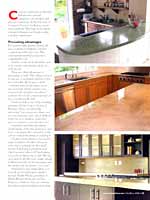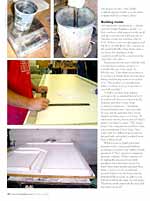Concrete Countertops
A two-part series covering forms, mixes, tools and finishes
Part 2: Precast Countertops
BY SUSAN BRIMO-COX
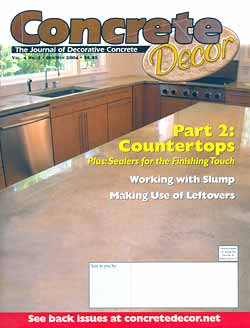
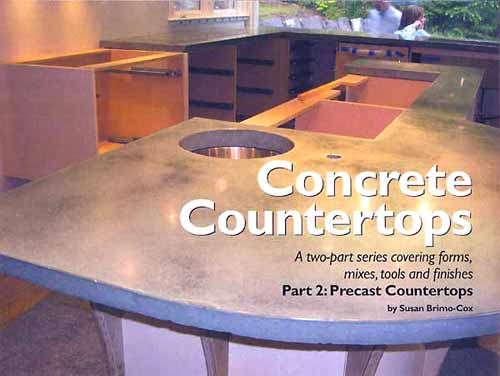
|
|
|
|
Concrete Countertop production falls into two general categories: cast-in-place and precast countertops. In the last issue of Concrete Decor, we looked at cast-in-place methods. This time we'll explore various techniques used in precasting concrete countertops.
Precasting advantages
If you prefer tight quality control, the precast method of making concrete countertops is the way to go. The environment in which you pour is controlled by you.
And if you also desire flexibility and more creative opportunity, again, go with precast.
There are other advantages to precasting, as well. "The stir-face created by precast vs. troweled concrete is a lot less permeable. [Its] easier to form overhangs and custom shapes on an inverted Pour, and it's easier to cast integral sinks and inlays in surfaces," explains Steve Eyler, owner/operator of Eycon in Myersville, Md.
Daniel Gobillot, one of the founding partners of Stone Soup Concrete in Florence, Mass., says that with precasting "you can get any shape, any size, any thickness, any color. I think its better in every Situation, unless the Piece is so massive you can't move it."
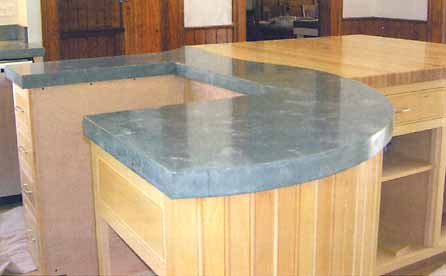
And this is probably the primary disadvantage of the precast process. You have to transport the Countertop to the job site without breaking or cracking it.
Another disadvantage is the need to make templates. "It takes a lot more time and traveling [to do this step]," reports Tom Ralston, president and chief executive officer of Tom Ralston Concrete in Santa Cruz, Calif "We use door skins to get the exact angles. [And] if different people do the measuring and the mold, some headaches can occur."
Nonetheless, precasting allows you to work on several projects simultaniously Buddy Rhodes, president of Buddy Rhodes Studio Inc. in San Francisco, observes, "Precast Counters [are] more suited for making more thanone project at once. Also, if [the countertop] goes 'south' you can make it again and have a happy client."
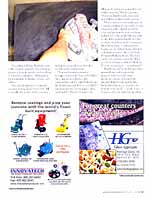 |
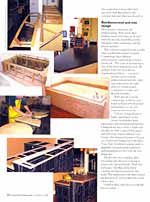 |
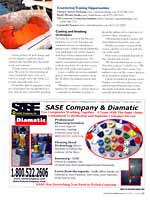 |
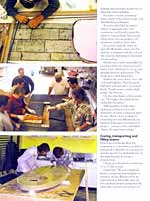 |
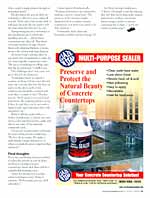 |
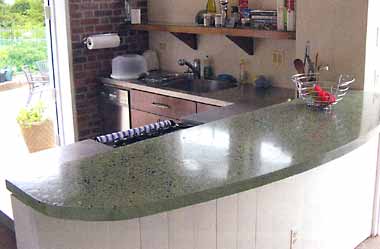
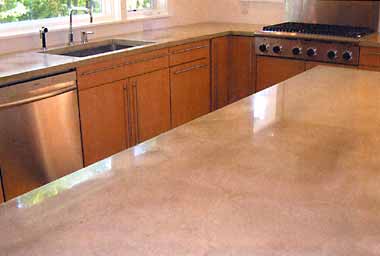
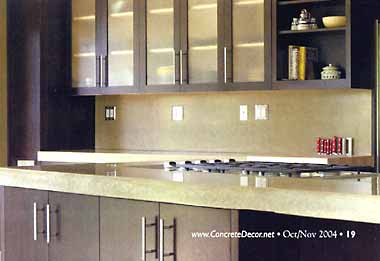
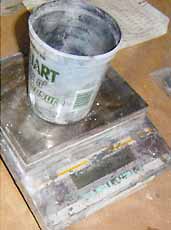
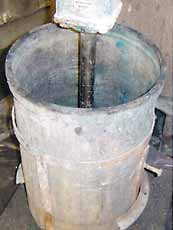
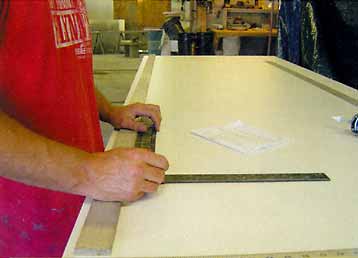
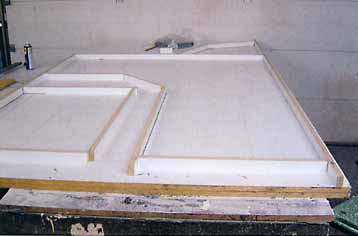
Building molds
An important consideration - before you even begin building a mold - is that you have solid support for the mold and the concrete YOU will pour into it. Another is that the molding table be level. If there is not enough Support and the floor or table flexes, the concrete in the mold will reflect that. If the table is not level, the thickness of the countertop will not be consistent from one end to the other.
Experienced contractors will also tell you that now is when You have to consider the size of the mold. As Rhodes says, "One thing about precast is you have to think about moving these things and placing seams at seven feet or so. The weight is a consideration when you have to move 'it up stairs or over hill and dale."
Gobillot explains that making sections to fit on standard 4-foot by 8-foot plywood sheets is common in the industry, and that's Stone Soup Concrete's preference. "Anything beyond that becomes a special order," he says, but he adds they have never turned anything away as too large. "It takes more money, but we haven't had a project too large to make." The largest project his company has tackled to-date was a countertop 12 feet long, 5 feet wide, with two different levels and an integral sink, and which weighed more than 1,400 pounds.
What you use to build your forms depends on the casting and finishing technique you plan to use. Jeffrey Girard, president of The Concrete Countertop Institute, explains, "If the concrete is to be minimally processed (very little grinding), then the forms need to be much more meticulously prepared than if the concrete is to be ground and grouted. Either way, the forms must be dimensionally accurate in order to cast slabs that will be the right size and shape. Therefore, sturdy materials like steel and melamine are good."
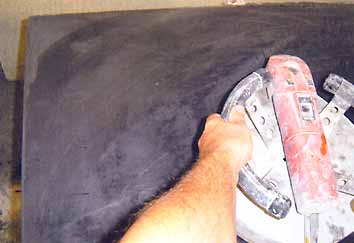
According to Eyler, "Building forms is like normal carpentry, but a bit more precise. On an inverted cast everything is formed as a negative." Materials he prefers include melamine, plastic and rubber.
Not only do materials commonly used for making molds need to be able to handle the weight of the concrete and create a smooth face, they also need to withstand moisture.
"You need water-resistant or waterproof materials," reports Gobillot. His company uses plastics and laminated wood. For a finish that looks like hand-troweled, they've used MDO (medium density overlay plywood) to build molds. "There's 10 ways to do
what we do and many materials to get to the same end." But he cautions, "Not every lumberyard carries good materials for working with concrete."
Most contractors who make precast concrete countertops use caulk or some other material to slightly round the edges and prevent the concrete from leaking out of the mold. Silicone caulk is one of the preferred methods. Once you have your basic mold constructed, then the real fun - and creativity begins, says Fu-Tung Cheng, principal and chief executive officer of Cheng Design in Berkeley, Calif. "The form can be the ultimate simplicity. What you do from there is what it's all about. It's your imagination - it's unlimited."
Rigid foam, rubber molds and other materials are used to create the negative forms for sinks, faucet knockouts, trivets and stand offs, integral drain boards, and the like. Embedded objects are affixed to the bottom of the mold - upside down, of course, so they are right side up when the countertop is de-molded and inverted. And then there is the concrete mix and what you do with it.
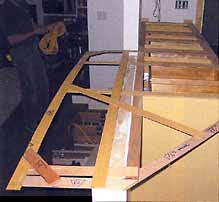
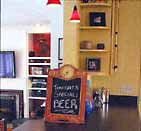

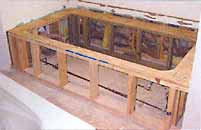
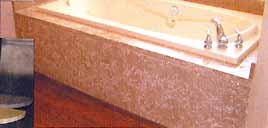
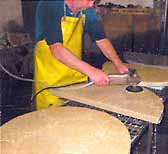
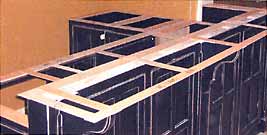


Reinforcement and mix design
Most precast contractors use reinforcement. Wire mesh, fiber reinforcement and rebar are all used with this process, depending on the thickness of the countertop and the project specifics.
But concrete countertops are not the same as sidewalks poured on-grade. Countertops have different reinforcement requirements, Girard points out. "The topic of reinforcing is one of the most misunderstood in the industry today. It's basically an engineering problem - you need primary and secondary reinforcement with the right materials and in the right places to ensure proper compressive, tensile and flexural strength."
With precast concrete countertops, aesthetics goes hand-in-hand with structural performance, so any old concrete mix won't do.
"Choice of ingredients is highly dependent on the desired workability, final appearance and structural performance. I designed my mix to have a high early strength in order to speed fabrication and deliver in a timely fashion," says Girard, who designed his mix to be cast on a Friday and stripped on a Monday. "I use Type I Portland cement, sand as aggregate, integral powder pigments and superplasticizer in a very dry zeroslump mix."
Rhodes also uses a thicker, drier, zero-slump mix when he is trying to achieve his "pressed finish." With this technique, handfuls of the thick concrete are hand-pressed into the mold. The haphazard voids thus created are intentional, and are filled later with a slurry mix.
Gobillot likes a mix that is workable, but not runny.
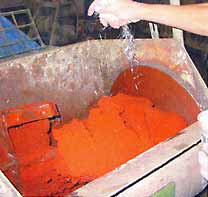
Cheng prefers a 6-inch slump, and uses his fingers to push his dense oatmeal-like NeoMix into the mold's nooks and crannies.
To help ensure consistency, Gobillot says, "We pour the whole kitchen at once, in multiple mixes, but each batch we weigh out to the 100th of a pound, especially with dyes."
Frequently, special aggregates (such as colored glass) are incorporated in a mix, and are later exposed by grinding.
Casting and finishing techniques
Each precast contractor has his own preference as to tools, but many use standard concrete, woodworking or granite tools. Gobillot says his preference is for gardening tools, which "seem to work better than construction tools."
From Ralston's perspective, "It's almost a necessity for precasters to have a whole repertoire of tools that let you get into little nooks and crannies."
Latex or rubber gloves are standard gear, as are respirators to protect from the ill effects of portland cement and sand.
Whether a concrete countertop needs to be vibrated - or how much so - depends on whether you plan to grout the surface with a slurry mix for creative effect, Girard says.
Vibrating the poured concrete will help eliminate bug holes and voids.
Finally, you want to screed off the excess concrete so it is level with the top of the mold.
How soon you unmold depends on the concrete mix you use.
"We de-form between two to four days after pouring," Gobillot says. "We begin sealing after three weeks. Our surfaces come out like a mirror finish so we go straight to sealing them."
Cheng recommends placing a moist blanket over the piece after it sets up, and leaving it there for one to three days while it hydrates and cures. He typically demolds four days after pouring; then lie waits another two to three days before grinding.
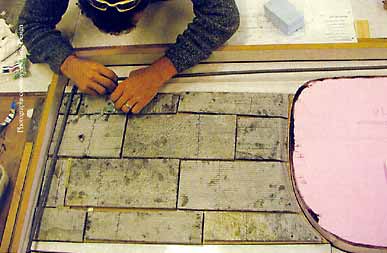
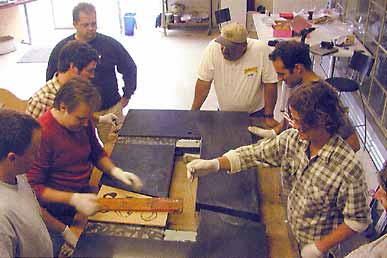
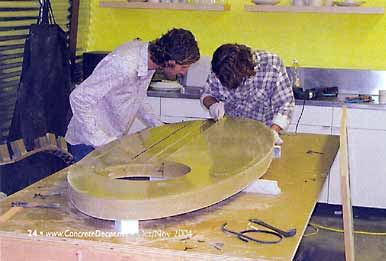
For some concrete countertop artists, much of the creative magic is in their finishing techniques.
If you've embedded decorative objects or aggregates into your countertop, you'll need to grind the surface to expose them. This can get rather messy, but can produce very satisfactory results in short order.
If you have bugholes, these are typically filled with a slurry mix that matches or contrasts with the color of the concrete, depending on the result you are seeking.
Rhodes uses voids to great effect by pressing a slurry into them in several applications, allowing it to set up, and grinding between applications. This results in a veined appearance.
Ralston also uses a slurry coat to fill voids and bugholes. Then he grinds with finer and finer grit to a polished finish. "People seem to prefer a light polish," he observes.
On the other hand, as Eyler points Out, "The higher the polish the less permeable the surface."
Still, regardless of individual preferences, Ralston echoes the sentiments of many contractors when he says, "We're always looking for something new and different [in our finishes]. It becomes an evolution of design - texture, colors, embedded objects. It's Much more unique."
Curing, transporting and filling seams
How long you should allow the countertop to cure before you deliver and install it depends on your process and the specific recommendations of the manufacturer if you use a prepared mix.
Cheng gives his precast countertops 10 to 29 days to Cure.
Girard says, "We can completely finish a countertop from template to install in 14 days. [However] we set expectations at 4-6 weeks, since we have multiple projects going on at the same time, and we're not going to be able to push a single project through at maximum speed."
Rhodes places his precast slabs on 2x4 sticks to allow for even curing all around. "If the slab is left on the table it will warp, because the top surface will dry faster than the bottom," he says.
Transporting precast countertops to the installation site is a little like handling artwork - which these countertops are, after all. Ship them vertically, stacked on edge. Protect them with shipping blankets or foam, protect the comers and strap them in.
At Stone Soup Concrete, they've invented a lot of equipment to make the job of moving the countertops easier. "We move everything on rolling carts that flip up and down," Gobillot says.
The challenges don't stop once you get to the job site, however.
"Sometimes when we install a counter we bring it from a nice [moist] place into a home that has the heat on and is in the direct path of the southern sun, [and] the counters will warp after a couple of days," Rhodes reports. "If the project is covered and kept moist, the warping will not occur. If they do curl they can be wet with a damp towels, and sometimes they will straighten out."
What to fill the seams with is a matter of preference. Colored, two-part epoxy, color-matched acrylic caulk, and silicon are some of the materials commonly used.
Cheng uses an innovative technique for seams in his precast countertops. "We key all our seams. We make a male-female tongue and groove, so when you push the pieces together they self-level."
Final thoughts
If you are considering trying your hand at either the precast or cast-in-place method of creating concrete countertops, know that there will be a considerable learning curve.
"Don't let anyone foot you that either technique is easy," Ralston cautions. "Both require practice, skill and talent."
Girard agrees wholeheartedly. "Training and practice are essential in making concrete countertops. The pioneers of the industry taught themselves how to make concrete countertops, but there is no need to do that anymore."
Fortunately, more classes are becoming available.
As Girard strongly emphasizes, "I always tell people to get the training they feel they need, then make samples and practice on their own homes before trying to make a concrete countertop for a client - don't use clients as guinea pigs.
Tom Ralston is a third-generation concrete contractor and the owner of Tom Ralston Concrete in Santa Cruz, Calif, which does structural, decorative, and specialty concrete work.


